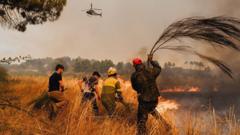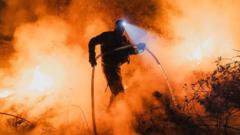Dozens of individuals were hospitalized during a graduation ceremony in Paterson, New Jersey, where over 150 attendees experienced heat-related illnesses, prompting the city's mayor to declare a state of emergency. In addition, six concertgoers were treated in Washington DC during a South Korean band performance, with authorities emphasizing the gravity of the situation.
The heatwave has affected more than 160 million people in the U.S. and Canada, with heat warnings in numerous states and regions including Ontario, Quebec, and Nova Scotia. Reports indicate that North Carolina residents, including children, have also sought medical help for heat-related issues, further stressing local healthcare resources.
In response to the crisis, local authorities have canceled recreational activities and opened cooling centers to help residents cope with the suffocating heat. The National Weather Service (NWS) has warned about the heightened risk of heat exhaustion and heat stroke, advising people to stay indoors during peak temperatures, hydrate frequently, and keep tabs on vulnerable populations.
Forecasts predict that this extreme heat event could break June records in several areas, with New York City potentially reaching historical highs of 101°F (38°C)—matching a peak temperature from 1966. Energy companies on the eastern seaboard have urged consumers to conserve power amid fears of potential blackouts as air conditioning usage surges.
With the summer season officially starting, experts caution that the extended heat, coupled with high humidity, could exacerbate existing health risks, affecting the well-being of many individuals across the impacted regions.
As the heatwave continues, communities and officials are urging all citizens to take necessary precautions and remain vigilant against the dangers posed by rising temperatures.
The heatwave has affected more than 160 million people in the U.S. and Canada, with heat warnings in numerous states and regions including Ontario, Quebec, and Nova Scotia. Reports indicate that North Carolina residents, including children, have also sought medical help for heat-related issues, further stressing local healthcare resources.
In response to the crisis, local authorities have canceled recreational activities and opened cooling centers to help residents cope with the suffocating heat. The National Weather Service (NWS) has warned about the heightened risk of heat exhaustion and heat stroke, advising people to stay indoors during peak temperatures, hydrate frequently, and keep tabs on vulnerable populations.
Forecasts predict that this extreme heat event could break June records in several areas, with New York City potentially reaching historical highs of 101°F (38°C)—matching a peak temperature from 1966. Energy companies on the eastern seaboard have urged consumers to conserve power amid fears of potential blackouts as air conditioning usage surges.
With the summer season officially starting, experts caution that the extended heat, coupled with high humidity, could exacerbate existing health risks, affecting the well-being of many individuals across the impacted regions.
As the heatwave continues, communities and officials are urging all citizens to take necessary precautions and remain vigilant against the dangers posed by rising temperatures.



















